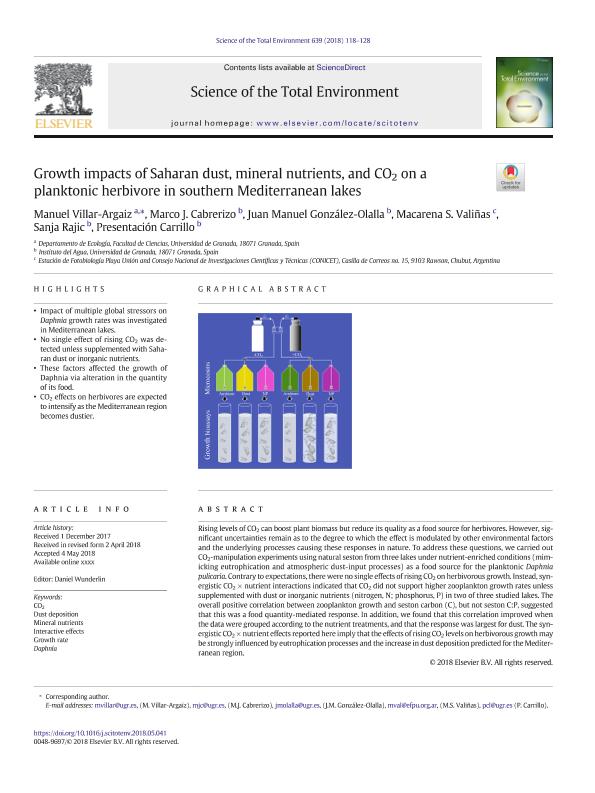Mostrar el registro sencillo del ítem
dc.contributor.author
Villar-Argaiz, Manuel
dc.contributor.author
Cabrerizo, Marco J.
dc.contributor.author
González-Olalla, Juan Manuel
dc.contributor.author
Valiñas, Macarena Soledad

dc.contributor.author
Rajic, Sanja
dc.contributor.author
Carrillo, Presentación
dc.date.available
2020-03-04T18:00:13Z
dc.date.issued
2018-10
dc.identifier.citation
Villar-Argaiz, Manuel; Cabrerizo, Marco J.; González-Olalla, Juan Manuel; Valiñas, Macarena Soledad; Rajic, Sanja; et al.; Growth impacts of Saharan dust, mineral nutrients, and CO2 on a planktonic herbivore in southern Mediterranean lakes; Elsevier Science; Science of the Total Environment; 639; 10-2018; 118-128
dc.identifier.issn
0048-9697
dc.identifier.uri
http://hdl.handle.net/11336/98765
dc.description.abstract
Rising levels of CO2 can boost plant biomass but reduce its quality as a food source for herbivores. However, significant uncertainties remain as to the degree to which the effect is modulated by other environmental factors and the underlying processes causing these responses in nature. To address these questions, we carried out CO2-manipulation experiments using natural seston from three lakes under nutrient-enriched conditions (mimicking eutrophication and atmospheric dust-input processes) as a food source for the planktonic Daphnia pulicaria. Contrary to expectations, there were no single effects of rising CO2 on herbivorous growth. Instead, synergistic CO2 × nutrient interactions indicated that CO2 did not support higher zooplankton growth rates unless supplemented with dust or inorganic nutrients (nitrogen, N; phosphorus, P) in two of three studied lakes. The overall positive correlation between zooplankton growth and seston carbon (C), but not seston C:P, suggested that this was a food quantity-mediated response. In addition, we found that this correlation improved when the data were grouped according to the nutrient treatments, and that the response was largest for dust. The synergistic CO2 × nutrient effects reported here imply that the effects of rising CO2 levels on herbivorous growth may be strongly influenced by eutrophication processes and the increase in dust deposition predicted for the Mediterranean region.
dc.format
application/pdf
dc.language.iso
eng
dc.publisher
Elsevier Science

dc.rights
info:eu-repo/semantics/openAccess
dc.rights.uri
https://creativecommons.org/licenses/by-nc-sa/2.5/ar/
dc.subject
CO2
dc.subject
DAPHNIA
dc.subject
DUST DEPOSITION
dc.subject
GROWTH RATE
dc.subject
INTERACTIVE EFFECTS
dc.subject
MINERAL NUTRIENTS
dc.subject.classification
Ecología

dc.subject.classification
Ciencias Biológicas

dc.subject.classification
CIENCIAS NATURALES Y EXACTAS

dc.title
Growth impacts of Saharan dust, mineral nutrients, and CO2 on a planktonic herbivore in southern Mediterranean lakes
dc.type
info:eu-repo/semantics/article
dc.type
info:ar-repo/semantics/artículo
dc.type
info:eu-repo/semantics/publishedVersion
dc.date.updated
2020-03-04T15:43:23Z
dc.journal.volume
639
dc.journal.pagination
118-128
dc.journal.pais
Países Bajos

dc.journal.ciudad
Amsterdam
dc.description.fil
Fil: Villar-Argaiz, Manuel. Universidad de Granada; España
dc.description.fil
Fil: Cabrerizo, Marco J.. Universidad de Granada; España
dc.description.fil
Fil: González-Olalla, Juan Manuel. Universidad de Granada; España
dc.description.fil
Fil: Valiñas, Macarena Soledad. Fundación Playa Unión. Estación de Fotobiología Playa Unión; Argentina. Consejo Nacional de Investigaciones Científicas y Técnicas; Argentina
dc.description.fil
Fil: Rajic, Sanja. Universidad de Granada; España
dc.description.fil
Fil: Carrillo, Presentación. Universidad de Granada; España
dc.journal.title
Science of the Total Environment

dc.relation.alternativeid
info:eu-repo/semantics/altIdentifier/doi/http://dx.doi.org/10.1016/j.scitotenv.2018.05.041
dc.relation.alternativeid
info:eu-repo/semantics/altIdentifier/url/https://www.sciencedirect.com/science/article/pii/S0048969718316735
Archivos asociados
